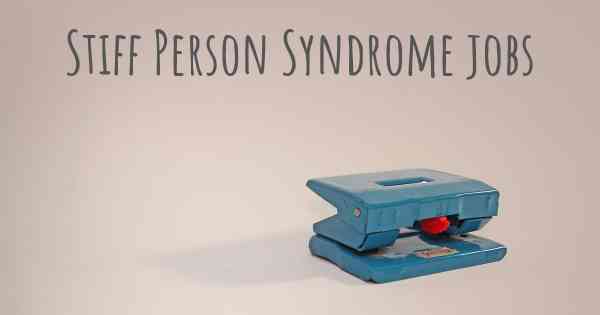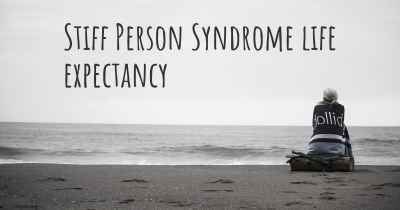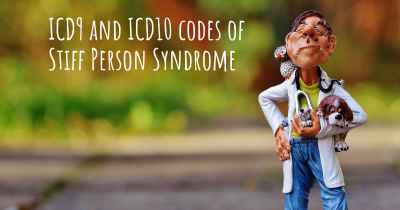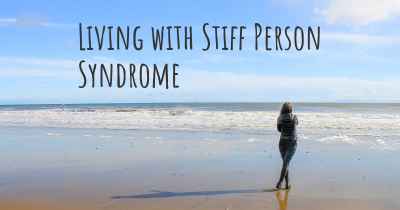Can people with Stiff Person Syndrome work? What kind of work can they perform?
See how people with experience in Stiff Person Syndrome give their opinion about whether people with Stiff Person Syndrome can work and what kind of jobs are more appropriated for people with Stiff Person Syndrome

Can people with Stiff Person Syndrome work?
Stiff Person Syndrome (SPS) is a rare neurological disorder characterized by muscle stiffness and spasms. It can significantly impact a person's mobility and daily activities. However, the ability to work with SPS varies depending on the severity of the condition and individual circumstances.
Employment opportunities for individuals with SPS:
1. Flexible work arrangements: Many individuals with SPS can continue working by adopting flexible work arrangements. This may include part-time work, working from home, or adjusting work hours to accommodate medical appointments and treatments.
2. Remote work: With the increasing availability of remote work options, individuals with SPS can explore job opportunities that allow them to work from the comfort of their homes. Remote work eliminates the need for commuting and provides a more comfortable environment for managing symptoms.
3. Self-employment: Starting a small business or working as a freelancer can provide individuals with SPS the flexibility to manage their own schedules and work at their own pace. This allows for better control over symptom management and reduces the stress associated with traditional employment.
4. Supportive work environments: Some workplaces are more accommodating and understanding of employees with disabilities. These environments may offer reasonable accommodations, such as modified workstations, flexible schedules, or additional breaks, to help individuals with SPS perform their job duties effectively.
Factors to consider:
1. Severity of symptoms: The severity of SPS symptoms can vary greatly among individuals. Some may experience mild symptoms that allow them to continue working, while others may have more severe symptoms that limit their ability to work. It is important to assess one's own symptoms and consult with healthcare professionals to determine the feasibility of employment.
2. Treatment and symptom management: Proper treatment and symptom management play a crucial role in enabling individuals with SPS to work. Medications, physical therapy, and assistive devices can help alleviate symptoms and improve functional abilities, increasing the likelihood of maintaining employment.
3. Support network: Having a strong support network, including healthcare professionals, family, and friends, can provide emotional and practical support for individuals with SPS. They can assist in managing symptoms, accessing appropriate accommodations, and navigating the challenges of the workplace.
Types of work suitable for individuals with SPS:
1. Desk-based jobs: Jobs that primarily involve desk work, such as administrative roles, writing, data entry, or graphic design, can be suitable for individuals with SPS. These jobs allow for minimal physical exertion and can be adapted to accommodate individual needs.
2. Consulting or advisory roles: Individuals with SPS who possess specialized knowledge or expertise can consider working as consultants or advisors in their respective fields. These roles often involve providing guidance, analysis, and recommendations, which can be done remotely or with flexible schedules.
3. Customer service or call center roles: Jobs that involve interacting with customers or clients over the phone or through online platforms can be suitable for individuals with SPS. These roles often provide the option to work from home and require minimal physical activity.
4. Online businesses: Individuals with SPS can explore opportunities in online businesses, such as e-commerce, content creation, blogging, or online tutoring. These ventures offer flexibility and can be tailored to individual capabilities and interests.
Conclusion:
While Stiff Person Syndrome can present challenges, many individuals with the condition can still work, given the right support, accommodations, and suitable job opportunities. It is essential to assess individual capabilities, consult with healthcare professionals, and explore flexible work arrangements or self-employment options to find a suitable work environment that accommodates the unique needs of individuals with SPS.
Work as long and for as many others as possible.
Posted Feb 28, 2017 by Loretta 1000
Others are able to work part time. The biggest obstacle for those that are able to work is the time they have to take off for infusions and appointments.
Most eventually reach a point that they will become unable to work.
People with Stiff Person Syndrome would probably find a flexible administrative position easiest as working jobs requiring the use of heavy equipment or a lot of driving probably would not be available to someone taking a lot of sedating medication.
Posted Mar 1, 2017 by Michelle 1500
A number of people do work for a while, but then find it becomes too difficult.
Posted Mar 1, 2017 by Liz 1000
Posted Mar 4, 2017 by Jasmine Nardone-Franco 1430
Forget high stress jobs, those where there's a lot of noise, motion, emotional distress, places you might receive even a light touch, open areas. These are all things that are triggers that can set off an episode of spasms, stiff or rigid muscles, falls, difficulty breathing and a number of problems associated with the disease.
Consider whether or not you can drive or have transportation to go to and from work. If your disease is advanced, how many days in a month would you miss work because of the disease. This can make a difference in whether or not you'd be considered by anyone for hire or if you should consult an attorney for the purposes of filing for disability. These are just some of the things I've gone through over time.
Though I don't know the percentage of people with SPS that may work, I know there are few people known to have the disease and few doctors that know what to look for or understand how to cope with it so it takes roughly seven years to diagnose if you have the GAD65 antibodies (though mine took 15-16 years). Not everyone has the antibodies. That said, I imagine even the undiagnosed keep working until they miss too much work or can't stand the pain and other symptoms.
Posted Sep 18, 2021 by hope7dre 300
Posted Dec 24, 2021 by Pathdoc 2500
I'm in my early 40's. Life just started to make sense. But even with the great care I received the the Minneapolis VA medical center. I suffer from exhaustion, muscle fatigue, dizziness, and double vision. Working for me, may not be in my future.
Posted Apr 27, 2022 by Yoland 100
Posted Sep 18, 2017 by Fernando Vela Vallejo 3250








